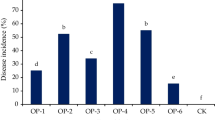Abstract
Powdery mildew is the one of the most severe and devastating disease of roses under protected cultivation. So under this study we have tried different ecofriendly approaches to manage the disease with the use of seven biological control agents (BCAs), nine bio-products and eight plant extracts. Under In vitro studies the highest efficacy was obtained with Bacillus subtilis, neem oil and Allium sativus at their higher concentrations. Among the BCAs the highest disease control was observed in Ampelomyces quisqualis (78.51%), Bacillus subtilis (74.12%), Verticillium lecanii (70.55%) and Trichoderma harzianum (67.33%) under the greenhouse conditions. From the bio-products best disease control was obtained with neem oil (76.18%) at 5% concentration. The best disease control was obtained with plant extract of Allium sativus (71.87%) at 20% concentration.
Similar content being viewed by others
References
Apte AR, Kamble SS (2008) Efficacy of carbendazim in combating castor blight in western Maharashtra. Bioinfolet 5:73–74
Channamma SG, Mahesh M, Kushal S (2015) Evaluation of botanical and biocontrol agents against the spore germination of Leveilulla taurica causing powdery mildew of gaur. Int J Trop Agric 33:3521–3523
Chee AA, Wurms KV, George M (2011) Control of powdery mildew (Sphaerotheca pannosa var. rosae) on rose (Rosa L. sp.) using anhydrous milk fat and soybean oil emulsions. New Zealand Plant Protect 64:195–200
Chovatiya AJ (2010) Management of powdery mildew disease of fenugreek (Trigonella foenum graecum L.). M.Sc. Thesis, Agricultural University, Junagadh, Gujrat, India, 57
Elsharkawy K, Nagwa MM, Kamel MSM (2014) Biological control of powdery and downy mildews of cucumber under greenhouse conditions. Egypt J Biol Pest Co 24:407–414
Gastelum FR, Rodriguez GH, Valenzuela CM (2014) First report of powdery mildew (Podosphaera pannosa) of roses in Sinaloa, Mexico. Plant Dis 98:1442
Janice FE, Haselhan C, Punja ZK (2011) Evaluation of biological control agents for control of botrytis blight of geranium and powdery mildew of rose. Can J Plant Pathol 33:499–505
Kim YS, Song JG, Lee I, Yeo WH, Yun BS (2013) Bacillus sp. BS061 suppresses powdery mildew and gray mold. Mycobiology 41:108–111
Kraus W (1995) Biologically active ingredients-azadirachtin and other triterpenoids. In: The Neem Tree Azadirachta indica A. Juss and Other Meliaceous Plants (Schutterer ed). Weinheim, New York, pp 35–88
Mahalakshmi P, Alice D (2013) Management of powdery mildew (Erisiphe polygoni) disease in green gram by plant extract. Int J Appl Biores 18:23–29
McKinney HH (1923) Influence of soil temperature and moisture on infection of wheat seedlings by Helminthosporium sativum. J Agric Res. 26:195–217
Odell DE, Smith J (1982) A simple method for spore germination studies. Bull Br Mycol Soc 16:159–161
Raja SA (2010) Management of powdery mildew, Phyllactinia corylea (Pers.) Karst of Mulberry (Morus sp.) using chosen biocontrol agents. J Biopest 3:483–486
Romero D, Vicentea AD, Zeriouha H, Cazorlaa FM, Ortunob D, Toresb JA, Garcia PA (2007) Evaluation of biological control agents for managing cucurbit powdery mildew on greenhouse grown melon. Plant Pathol 56:976–986
Sahni ML (1987) Reaction of some rose cultivars to powdery mildew fungus. Indian Phytopathol 40:534–535
Tobamy MRA, Moity AEI, Atia M, Moneim MLA (2002) Evaluation of some plant extracts in control of damping-off and mildew diseases of cucumber. Egypt J Phytopathol 30:71–80
Wojdyla AT (2000) Influence of some compounds on development of Sphaerotheca pannosa var. rosae. J Plant Prot Res 40:106–121
Author information
Authors and Affiliations
Corresponding author
Rights and permissions
About this article
Cite this article
Kumar, V., Chandel, S. Management of rose powdery mildew (Podosphaera pannosa) through ecofriendly approaches. Indian Phytopathology 71, 393–397 (2018). https://doi.org/10.1007/s42360-018-0050-y
Received:
Revised:
Accepted:
Published:
Issue Date:
DOI: https://doi.org/10.1007/s42360-018-0050-y




